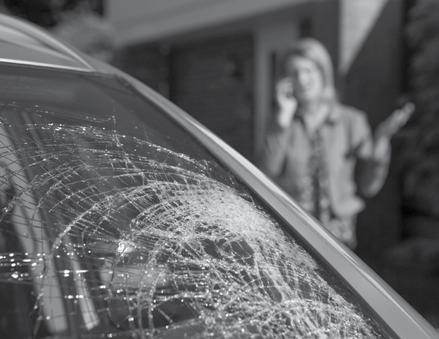
3 minute read
Auto Wise
Windshield Damage
Repair or Replace?
Advertisement
By Brie Hellbusch
When operating a vehicle, safety should always be your highest priority. In addition to defensive driving and diligently following the rules of the road, this also means ensuring that every aspect of the car is up to snuff, including the vehicle’s windshield. The main purpose of a car’s windshield is to act as a safety device that shields vehicle passengers from a variety of hazards, such as wind, water, and debris. It also helps to reduce crash injuries by preventing most outside objects from entering the vehicle.
Even on impact, a windshield doesn’t shatter like regular glass. Like many vehicle safety features, windshield technology has come a long way. Today’s modern auto glass is laminated glass. It is strong, like tempered glass, but it bends slightly upon impact, allowing for additional protection against shattering. Because the windshield plays such a vital role for road safety, experts agree that it’s wise to always repair or replace a damaged windshield.
As you might guess, repairing a chipped windshield costs less than replacing the windshield entirely. How do you decide when a replacement is warranted? It depends mostly on the size and location of the damage. For example, for chips that are smaller than a quarter and cracks that are less than a few inches long, there’s typically no need to replace the entire windshield. However, some states do not allow glass repairs in areas that are directly in the driver’s line of vision because even small fixes can create distortion that can potentially affect visibility. Additionally, specialists recommend replacing any windshield that has a crack extending from an edge, no matter how small the damage, because these cracks tend to spread quickly.
The glass repair process for chips and cracks involves injecting a polymer resin into the damaged spot, allowing it to dry, and then smoothing the surface so the damage is no longer visible. This precision task is best left to an experienced professional to ensure the job is done right. Your visibility depends on it!
Some auto insurance companies will cover glass repairs with no deductible because it costs less than windshield replacement, but other carriers prefer that damaged windshields always be replaced instead of repaired. It’s wise to consult your insurer before you schedule your service so there are no surprises when it comes time to pay the bill.
As soon as a repair or replacement is needed, contact your insurance company to arrange a service appointment. Insurance carriers often use third-party companies to manage windshield replacement claims. You’ll get a call from the company, and they will typically recommend qualified installers. It’s always good to keep in mind that you are not required to choose an installer that they recommend. You still have the final say on who performs the glass repair on your vehicle. If you want to choose a different auto glass specialist, you may.
Some car owners who are having a windshield installed want to take it a step further and opt for windshield tinting. (Do your research first! Car window tinting laws vary by state.) It’s important to know what you want out of your tinted windshield so that you can choose the right one for your vehicle. There are more than 1,000 individual blends of window tints available, including transparent tints designed for visual enhancement and tints that provide infrared protection with superior clarity.
One affordable option is the dyed window tint, which blocks sunlight with multiple layers of infused dyes that absorb solar heat to reduce the potential of increasing cabin temperature. However, this blend doesn’t necessarily provide protection against UV exposure. Another popular option is the metalized window tint, which offers glare reduction and is effective at blocking heat and UV rays from entering the vehicle.
Some prefer to mesh these two choices and go with the hybrid dye and metallic tint film. It isn’t too dark or reflective, making it good for blocking UV rays and reducing sun exposure inside. This mid-level tinted film doesn’t negatively impact night driving.
The ceramic window tint is another very good choice, as it can block up to 50 percent of solar heat without any reduction in visibility. This option also produces outstanding shatter resistance, reduces glare, and effectively blocks 99.9 percent of UV exposure.
If one thing is certain, it’s that a clear windshield isn’t just cosmetic—its good repair is crucial to the safety of the driver, passengers, and everyone else on the road. Don’t wait to see if that crack will get any bigger (spoiler alert: it will!). Check with an expert to see if your damaged windshield needs repair or replacement—for your safety and mine!
Sources for this article included: aaa.com, carwindwhields.info, and ceramicpro.com.








